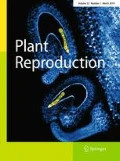Abstract
Long-, mid-, and short-styled clonal accessions of oca (Oxalis tuberosa) were intercrossed in a complete diallelic design. Pollen tube growth in styles was monitored in all diallelic crosses. Pollen fertility was estimated by two tests: staining of pollen grains with aceto-carmine and detection of β-galactosidase activity by the substrate X-Gal. The two methods of pollen fertility estimation were equally useful to detect fertility levels. Pollen originating from short stamens had the highest fertility (85%) and pollen from long stamens had the lowest fertility (70%). Pollen fertility was high throughout, but its degree varied with the stylar morph on which the pollen was formed. Long-styled accessions had the highest rates of fertile pollen. Differences in pollen fertility at different anther levels in the same style morph were also apparent. Pollen grain diameter of the six morph-anther level combinations was inversely correlated with pollen fertility. Pollen grains from long stamens were the largest and pollen grains from short stamens were the smallest. Neither pollen fertility nor pollen grain size had an influence on pollen tube growth in the style or on fruit and seed set. Pollen tubes growing within the styles were inhibited at a different level for each of the 18 cross combinations in the diallel. Although legitimate crosses had greatest pollen tube growth, some of the illegitimate inter- and intramorph crosses had equally high scores. Of all illegitimate crosses, mid-styled seed parents had the lowest level of stylar incompatibility. Fruit and seed set were highly correlated with the extent of pollen tube growth in the style. The number of pollen tubes entering ovules in a flower was in good agreement with the number of seeds produced per fruit. Therefore, it is concluded that stylar incompatibility is the major determinant of limited seed formation in oca even in the most successful legitimate cross combinations.
Similar content being viewed by others
Author information
Authors and Affiliations
Additional information
Received: 1 September 1999 / Revision accepted: 4 April 2000
Rights and permissions
About this article
Cite this article
Trognitz, B., Carrión, S. & Hermann, M. Expression of stylar incompatibility in the Andean clonal tuber crop oca (Oxalis tuberosa Mol., Oxalidaceae). Sex Plant Reprod 13, 105–111 (2000). https://doi.org/10.1007/s004970000040
Issue Date:
DOI: https://doi.org/10.1007/s004970000040




